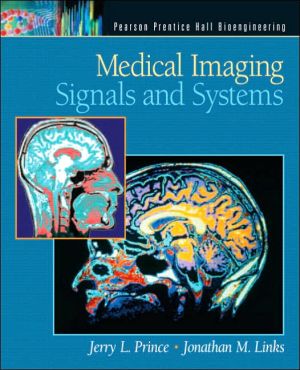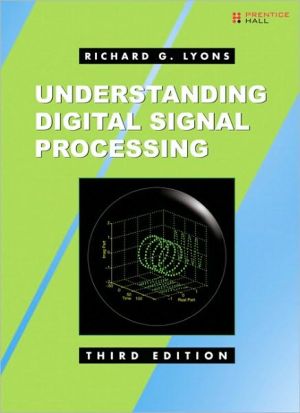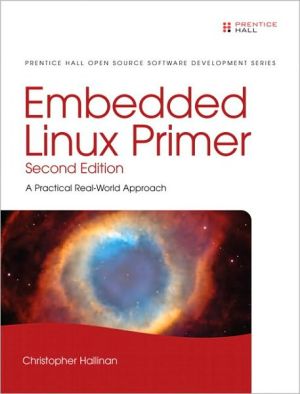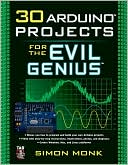Medical Imaging Signals and Systems
Search in google:
This book has developed over the past 14 years, during which time we have taught a course on medical imaging systems at Johns Hopkins University. This course started out as a survey course, and then evolved according to our mutual interests and inclinations into a course that emphasizes the signals and systems aspects—or more precisely, the signal processing aspects—of medical imaging.\ With signal processing as the fundamental viewpoint, this book covers the most important imaging modalities in radiology: projection radiography, x-ray computed tomography, nuclear medicine, ultrasound imaging, and magnetic resonance imaging. The authors expect the reader to be familiar with signals and systems, which are usually covered in the sophomore year of most engineering curricula, and with elementary probability. Freshman courses in physics, chemistry, and calculus are also assumed.\ The book is organized into parts emphasizing key overall conceptual divisions, as follows. Part I introduces basic imaging principles, including an introduction to medical imaging systems in Chapter 1, a review of signal processing in Chapter 2 (with emphasis on two-dimensional signals), and a discussion of image quality in Chapter 3. Our presentation of the theory of medical imaging systems is strongly based on continuous signals; however, a development of discrete signals is included to permit discussions on sampling and implementation. Issues of image quality, including resolution, noise, contrast, geometric distortion, and artifacts are described in general context here, but revisited within each modality in subsequent chapters.\ Part II describes key modalities in radiographic imaging. It begins in Chapter 4 with a brief presentation of the physics of radiography, including the generation and detection of ionizing radiation and its effect on the human body. Chapter 5 describes projection radiography systems, including chest x-ray and fluoroscopy systems. As in all subsequent chapters, coverage focuses on signals, including only enough physics and biology to motivate the modality and provide a model for the analysis. Chapter 5 also presents the mathematics of projection imaging, a very fundamental idea in medical imaging. Chapters 6 covers x-ray computed tomography, expanding on the instrumentation and mathematics of projection imaging and introducing the concept of image reconstruction in medical imaging. Computed tomography produces true tomograms (images of cross sections of the body) rather than projections of the body.\ Part IV presents the physics and modalities of nuclear medicine imaging. Chapter 7 describes the physics of nuclear medicine, focusing primarily on the concept of radioactivity. The major modalities in nuclear medicine imaging are described in Chapter 8, which covers planar scintigraphy, and Chapter 9, which covers emission computed tomography.\ Part IV covers ultrasound imaging. It begins in Chapter 10 with a brief presentation of the physics of sound, and continues in Chapter 11 with the various imaging modes offered within this rich modality. Part V covers magnetic resonance imaging. Chapter 11 presents the physics of nuclear magnetic resonance, and Chapter 12 continues with a presentation of various magnetic resonance imaging techniques.\ We have used drafts of this book for a one-semester upper-level/graduate course on medical imaging systems. In order to cover the material in one semester, we routinely skip some material in the book and we move at a very brisk pace. We feel that this book could be used in a two-semester course as well, perhaps by covering Parts I-III in the first semester and Parts IV-V in the second semester. A two-semester approach would allow instructors to use supplementary materials for additional depth or to present current research topics.\ Medical imaging is very visual—just ask any radiologist. Although the formalism of signals and systems is mathematical, we understand the advantages offered through visualization. Therefore, the book contains many images and diagrams. Some are strictly pedagogical, offered in conjunction with the exposition or an example problem. Others are motivational, 'revealing interesting features for discussion or study. Special emphasis is made to provide biologically relevant examples including images, so that the important context of medical imaging can be appreciated by students.\ Many students, friends, colleagues, and teaching assistants contributed to this book through discussions and critiques. Xiao Han, Li Pan, and Vijay Parthasarathy contributed problems and solutions, and Aaron Carass fixed many LaTeX and CVS problems. A special note of appreciation is due to Xiaodong Tao, who created and solved many of the examples and problems. We would also like to thank Rama Chellappa, Brian Caffo, and Sarah Ying, who provided comments and suggestions on several parts of the book. We also thank William R. Brody, who inspired the creation of the course out of which this book grew and who also wrote one of the chapters in our original course notes. Finally, we convey special thanks to Elliot R. McVeigh and John I. Goutsias, who co-taught our course at Hopkins during the early years and helped draft the original version of this book.\ JERRY L. PRINCE JONATHAN M. LINKS
PrefacePart I: Basic Imaging Principles Overview.Chapter 1Introduction. History of Medical Imaging. Physical Signals. Imaging Modalities. Projection Radiography. Computed Tomography. Nuclear Medicine. Ultrasound Imaging. Magnetic Resonance Imaging. Summary and Key Concepts.Chapter 2: Signals and Systems.Introduction. Signals. Point Impulse. Line Impulse. Comb and Sampling Functions. Rect and Sinc Functions. Exponential and Sinusoidal Signals. Separable Signals. Periodic Signals. Systems. Linear Systems. Impulse Response. Shift Invariance. Connections of LSI Systems. Separable Systems. Stable Systems. The Fourier Transform. Properties of the Fourier Transform. Linearity. Translation. Conjugation and Conjugate Symmetry. Scaling. Rotation. Convolution. Product. Separable Product. Parseval’s Theorem. Separability. Transfer Function. Circular Symmetry and the Hankel Transform. Sampling. Sampling Signal Model. Nyquist Sampling Theorem. Anti-aliasing Filters. Summary and Key Concepts.Chapter 3: Image Quality.Introduction. Contrast. Modulation. Modulation Transfer Function. Local Contrast. Resolution. Line Spread Function. Full Width at Half Maximum. Resolution and Modulation Transfer Function. Subsystem Cascade. Resolution Tool. Temporal and Spectral Resolution. Noise. Random Variables. Continuous Random Variables. Discrete Random Variables.Independent Random Variables. Signal-to-Noise Ratio. Amplitude SNR. Power SNR. Differential SNR. Nonrandom Effects. Artifacts. Distortion. Accuracy. Quantitative Accuracy. Diagnostic Accuracy. Summary and Key Concepts.Part II: Radiographic Imaging.Overview.Chapter 4: Physics of Radiography.Introduction. Ionization. Atomic Structure. Electron Binding Energy. Ionization and Excitation. Forms of Ionizing Radiation. Particulate Radiation. Electromagnetic Radiation. Nature and Properties of Ionizing Radiation. Primary Energetic Electron Interactions. Primary Electromagnetic Radiation Interactions. Attenuation of Electromagnetic Radiation. Measures of X-ray Beam Strength. Narrow Beam, Monoenergetic Photons. Narrow Beam, Polyenergetic Photons. Broad Beam Case. Radiation Dosimetry. Exposure. Dose and Kerma. Linear Energy Transfer. The f —factor. Dose Equivalent. Effective Dose. Summary and Key Concepts.Chapter 5: Projection Radiography.Introduction. Instrumentation. X-ray Tubes. Filtration and Restriction. Compensation Filters and Contrast Agents. Grids, Airgaps, and Scanning Slits. Film-Screen Detectors. X-ray Image Intensifiers. Image Formation. Basic Imaging Equation. Geometric Effects. Blurring Effects. Film Characteristics. Noise and Scattering. Signal-to-Noise Ratio. Quantum Efficiency and Detective Quantum Efficiency. Compton Scattering. Summary and Key Concepts.Chapter 6: Computed Tomography.Introduction. CT Instrumentation. CT Generations. X-ray Source and Collimation. CT Detectors. Gantry, Slip Ring, and Patient Table. Image Formation. Line Integrals. CT Numbers. Parallel-Ray Reconstruction. Fan-Beam Reconstruction. Helical CT Reconstruction. Cone Beam CT. Image Quality in CT. Resolution. Noise. Artifacts. Summary and Key Concepts.Part III: Nuclear Medicine Imaging.Overview.Chapter 7: The Physics of Nuclear Medicine.Introduction. Nomenclature. Radioactive Decay. Mass Defect and Binding Energy. Line of Stability. Radioactivity. Radioactive Decay Law. Modes of Decay. Positron Decay and Electron Capture. Isomeric Transition. Statistics of Decay. Radiotracers. Summary and Key Concepts.Chapter 8: Planar Scintigraphy.Introduction. Instrumentation. Collimators. Scintillation Crystal. Photomultiplier Tubes. Positioning Logic. Pulse Height Analyzer. Gating Circuit. Image Capture. Image Formation. Event Position Estimation. Acquisition Modes. Anger Camera Imaging Equation. Image Quality. Resolution. Sensitivity. Uniformity. Energy Resolution. Noise. Factors Affecting Count Rate. Summary and Key Concepts.Chapter 9: Emission Computed Tomography.Instrumentation. SPECT Instrumentation. PET Instrumentation. Image Formation. SPECT Image Formation. PET Image Formation. Iterative Reconstruction. Image Quality in SPECT and PET. Spatial Resolution. Attenuation and Scatter. Random Coincidences. Contrast. Noise and Signal-to-Noise. Summary and Key Concepts.Part IV: Ultrasound Imaging.Overview.Chapter 10: The Physics of Ultrasound. Introduction. The Wave Equation. Three-Dimensional Acoustic Waves. Plane Waves. Spherical Waves. Wave Propagation. Acoustic Energy and Intensity. Reflection and Refraction at Plane Interfaces. Transmission and Reflection Coefficients at Plane Interfaces. Attenuation. Scattering. Doppler Effect. Beam Pattern Formation and Focusing. Simple Field Pattern Model. Diffraction Formulation. Focusing. Summary and Key Concepts.Chapter 11: Ultrasound Imaging Systems.Introduction. Instrumentation. Ultrasound Transducer. Ultrasound Probes. Pulse-Echo Imaging. The Pulse-Echo Equation. Transducer Motion. Ultrasound Imaging Modes. A-Mode Scan. M-Mode Scan. B-Mode Scan. Steering and Focusing. Transmit Steering and Focusing. Beamforming and Dynamic Focusing. Three-Dimensional Ultrasound Imaging. Summary and Key Concepts.Part V: Magnetic Resonance Imaging.Overview.Chapter 12: Physics of Magnetic Resonance.Introduction. Microscopic Magnetization. Macroscopic Magnetization. Precession and Larmor Frequency. Transverse and Longitudinal Magnetization. NMR Signals. Rotating Frame. RF Excitation. Relaxation. The Bloch Equations. Spin Echoes. Contrast Mechanisms. Summary and Key Concepts.Chapter 13: Magnetic Resonance Imaging.Instrumentation. System Components. Magnet. Gradient Coils. Radio-Frequency Coils. Scanning Console and Computer. MRI Data Acquisition. Encoding Spatial Position. Slice Selection. Frequency Encoding. Polar Scanning. Gradient Echoes. Phase Encoding. Spin Echoes. Pulse Repetition Interval. Realistic Pulse Sequences. Image Reconstruction. Rectilinear Data. Polar Data. Imaging Equations. Image Quality. Sampling. Resolution. Noise. Signal-to-Noise Ratio. Artifacts. Summary and Key Concepts. Index.








